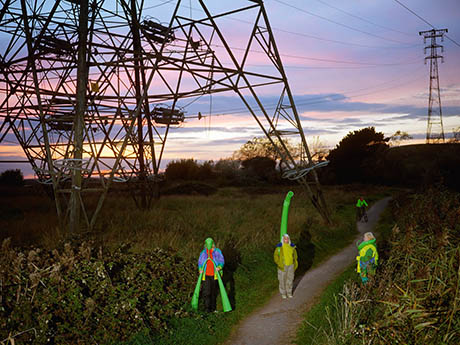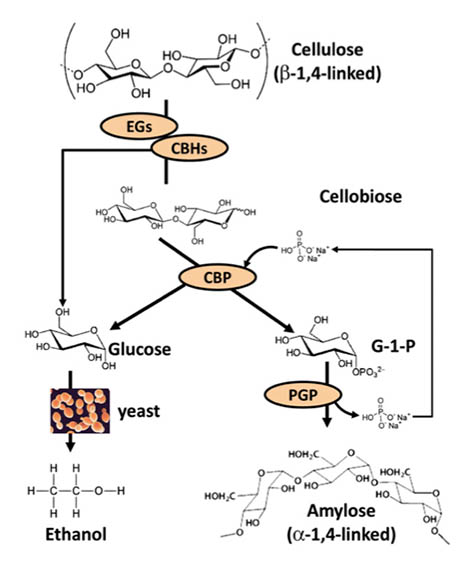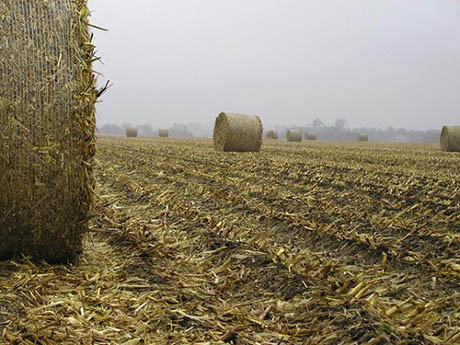Back in 2009, speculative designers Dunne & Raby were commissioned by Design Indaba to think about the problem of feeding nine billion people by 2050.
They looked at United Nations reports predicting that food demand will increase by seventy percent over the next forty years; they considered the arguments of pro-GMO foundations and individuals, who frequently claim that hacking the DNA of food crops in order to make them more productive and nutritious is the only feasible way to meet that challenge; and they noticed that one possible approach was consistently overlooked: the option to modify ourselves, instead.

IMAGE: Foragers, 2009, Dunne & Raby.
As Anthony Dunne explained in a 2010 interview with me, their proposal, Foragers, imagines a scenario in which a group of people “would reject industrial and governmental approaches to food shortages and instead would use DIY synthetic biological processes combined with the spirit of foraging to redesign themselves to different degrees, so that they could digest non-human foods like grass and cellulose and so on.”
Once we defined this group of people that hybridized existing trends, and we knew what the technology would be, we started to explore what would be the most compelling way to visualize it, so that it would be an interesting thing to think about and speculate upon.
We wanted to get people thinking and talking about whether it’s actually worth looking at how we might modify ourselves to increase the range of foods that we can digest, or whether we should limit our focus to different ways of using land or designing plants to produce more food.

IMAGE: Foragers, 2009, Dunne & Raby
Dunne & Raby were quite clear about the intention behind their designs: the project was a thought experiment, designed to provoke people into questioning their assumptions, rather than a collection of working, science-based prototypes.
However, it seems as though science has now caught up with fiction: in a paper published online in the Proceedings of the National Academy of Sciences earlier this week, researchers at Virginia Polytechnic Institute and State University reported on a successful proof-of-concept experiment that used synthetic biology to transform indigestible cellulose into edible starch, in the form of amylose.
The scientists borrowed genes from bacteria, soil fungi, and potatoes and inserted them into E. coli, the workhorse bacteria of synthetic biology, in order to produce the enzymes required to first break down cellulose into smaller components and then reassemble them into starch, in a two-step, one-pot process.
Speaking to Science, one of the researchers described the final product: “No taste in the beginning. After chewing for a while, it tasted slightly sweet.”

IMAGE: From Chun You, Hongge Chen, Suwan Myung, Noppadon Sathitsuksanoh, Hui Ma, Xiao-Zhou Zhang, Jianyong Li, and Y.-H. Percival Zhang, “Enzymatic transformation of nonfood biomass to starch.” The team’s two-step process first breaks cellulose into cellobiose, a compound made from a pair of glucose molecules, and then reassembles it. Between one third to half of the original cellulose can be transformed into amylose; the rest becomes glucose, which can be converted into ethanol for use as a biofuel by yeast.
Despite the final product’s underwhelming sensory profile, the discovery of a process that can render cellulose edible for humans is undeniably exciting: cellulose is the most abundant carbohydrate on Earth.
The paper’s authors, Y.-H. Percival Zhang and Hongge Chen, explain that “the annual resource of cellulosic materials is ∼40 times greater than the starch produced by crops cultivated for food and feed,” and that “every ton of cereals harvested is usually accompanied by the production of two to three tons of cellulose-rich crop residues,” most of which are currently burned or left in place (where they protect and improve soil). What’s more, perennial cellulosic plants don’t require the high-quality land, water, and fertiliser and pesticide inputs of corn, wheat, and soya.

IMAGE: Bales of corn stover (photograph by Wally Wilhelm via Science Daily). Stover, which You, Chen, et al. used as their cellulose source, is often left in place or burned.
No wonder, then, that Zhang and Chen conclude with the claim that “the cost-effective transformation of nonfood cellulose to starch could revolutionize agriculture and reshape the bioeconomy, while maintaining biodiversity, minimizing agriculture’s environmental footprint, and conserving fresh water.”
Extrapolating from the amount of cellulose produced each year, this process could potentially provide up to thirty percent of the extra food the UN’s projections demand by 2050. Fascinatingly, Zhang credits China’s history of famine as his motivation, explaining to Science that: “Food security has always been the number one question for nearly 5000 years of Chinese history. Without enough food, crises happened and dynasties shifted.”
Zhang is quick to point out that the process is not cost-effective yet, estimating that it would currently cost “about $1 million to turn 200 kilograms of crude cellulose into 20 kilograms of starch, about enough to feed one person’s carbohydrate needs for 80 days.” Nonetheless, they plan to commercialise the process, and with five or ten years’ more research, Zhang tells Science that he could imagine companies doing the same thing for just $40.

IMAGE: Foragers, 2009, Dunne & Raby.
Despite its similarities to Dunne & Raby’s vision of using synthetic biology to expand the category of food plants, Zhang and Chen are careful to explain that they imagine their process being carried out in scaled-up cellulosic biorefineries, rather than personal digestive prosthetics, precisely to avoid the controversy that surrounds genetic modification and DNA hacking:
Because in vitro building blocks cannot duplicate themselves, the large-scale implementation of cellulose-to-starch in future biorefineries would not raise the questions about ethics, biosecurity, and biosafety that are often confronted by in vivo synthetic biology projects.
Beyond the question of where exactly we should intervene in the food chain — whether it’s better to modify ourselves, or our dinner — this difference points to the real dilemma embedded in almost all technological solutions to increase food production: sovereignty.
Dunne & Raby’s future foragers embody a bottom-up approach, independent of corporations and government regulation, and based on an ethos of gathering rather than cultivation; Zhang and Chen’s giant biorefineries simply incorporate woody stems and synthetic lifeforms into the structure of our current industrial agrifood system. Choosing which you find more attractive, as well as which you find more plausible, is something of litmus test.

